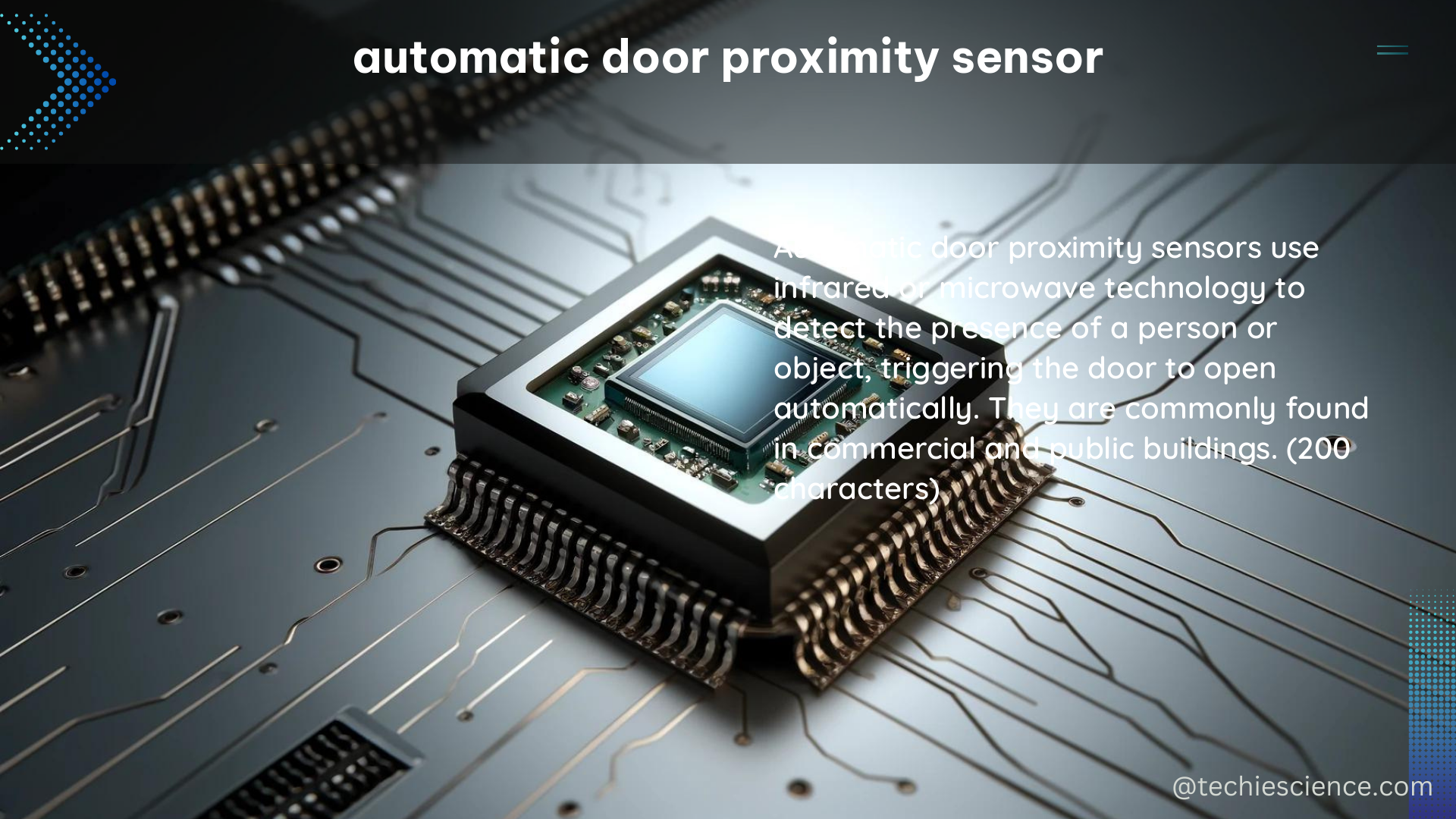Automatic door proximity sensors are essential components in modern buildings, ensuring seamless and efficient access control. These sensors utilize advanced technologies to detect the presence of individuals or objects within a specific range, triggering the automatic opening and closing of doors. In this comprehensive guide, we will delve into the technical specifications, types, and measurable data points that are crucial in understanding and selecting the right automatic door proximity sensor for your application.
Technical Specifications of Automatic Door Proximity Sensors
Automatic door proximity sensors can vary in their technical specifications depending on the manufacturer and model. However, some common specifications include:
- Detection Range: Automatic door proximity sensors typically have a detection range of up to several meters, allowing them to effectively monitor the area in front of the door.
- Response Time: These sensors are designed to have a rapid response time, often less than 1 second, ensuring immediate door activation upon detection.
- Operating Frequency: Automatic door proximity sensors operate within a frequency range of 10-100 kHz, utilizing various technologies such as infrared, ultrasonic, or microwave to detect the presence of objects or people.
Types of Automatic Door Proximity Sensors

Automatic door proximity sensors can be categorized into different types based on the underlying technology they employ:
- Capacitive Proximity Sensors: These sensors detect the presence of a person or object by measuring changes in an electric field. They are particularly effective in sensing the human body, as it acts as a conductive surface, altering the electric field.
- Inductive Proximity Sensors: Inductive proximity sensors use a magnetic field to detect the presence of metal objects. They are commonly used in applications where the door needs to be triggered by the presence of a vehicle or a metal object.
- Photoelectric Proximity Sensors: Photoelectric sensors utilize light-emitting diodes (LEDs) and photodetectors to create an invisible light beam. When this beam is interrupted by an object or person, the sensor triggers the door to open.
- Ultrasonic Proximity Sensors: These sensors emit high-frequency sound waves and measure the time it takes for the waves to reflect off an object and return to the sensor. This information is then used to detect the presence and distance of the object.
Measurable and Quantifiable Data Points
When evaluating the performance and suitability of an automatic door proximity sensor, several measurable and quantifiable data points should be considered:
- Accuracy: Accuracy is a crucial factor and can be measured in terms of false positive and false negative rates. A sensor with a low false positive rate is less likely to trigger the door unnecessarily, while a low false negative rate ensures reliable detection of people or objects.
- Reliability: Reliability is often measured by the sensor’s mean time between failures (MTBF) or its failure rate. A sensor with a high MTBF or low failure rate is more dependable and requires less maintenance over time.
- Power Consumption: Power consumption is an important consideration, especially in applications where energy efficiency is a priority. This can be measured in terms of the sensor’s current draw or power consumption in watts.
- Mounting Options: Automatic door proximity sensors may offer various mounting options, such as surface-mount, flush-mount, or recessed-mount, to accommodate different installation requirements and aesthetics.
- Environmental Resistance: Depending on the application, the sensor’s resistance to environmental factors, such as temperature, humidity, and dust, may be a critical consideration.
- Connectivity and Integration: Some automatic door proximity sensors offer advanced features like wireless connectivity or integration with building management systems, allowing for remote monitoring and control.
Selecting the Right Automatic Door Proximity Sensor
When selecting an automatic door proximity sensor, it is essential to consider the specific requirements of your application, such as the door size, traffic volume, and environmental conditions. By carefully evaluating the technical specifications, sensor types, and measurable data points, you can ensure that the chosen sensor meets the necessary performance and reliability standards, while also aligning with your energy efficiency and integration requirements.
Conclusion
Automatic door proximity sensors play a crucial role in modern building infrastructure, providing seamless access control and enhancing the overall user experience. By understanding the technical details, sensor types, and measurable data points, you can make an informed decision when selecting the right automatic door proximity sensor for your application. This comprehensive guide has provided you with the necessary knowledge to navigate the world of automatic door proximity sensors and make an informed choice that meets your specific needs.
Reference:
- NUREG-1959 “Intrusion Detection Systems and Subsystems” – https://www.nrc.gov/docs/ML1111/ML11112A009.pdf
- MIL-STD-881F “Department of Defense Standard Practice” – https://cade.osd.mil/Content/cade/files/coplan/MIL-STD-881F_Final.pdf
- Wireless E911 Location Accuracy Requirements – https://www.911.gov/assets/Wireless-E911-Location-Accuracy-Requirements-1638567121.pdf

The lambdageeks.com Core SME Team is a group of experienced subject matter experts from diverse scientific and technical fields including Physics, Chemistry, Technology,Electronics & Electrical Engineering, Automotive, Mechanical Engineering. Our team collaborates to create high-quality, well-researched articles on a wide range of science and technology topics for the lambdageeks.com website.
All Our Senior SME are having more than 7 Years of experience in the respective fields . They are either Working Industry Professionals or assocaited With different Universities. Refer Our Authors Page to get to know About our Core SMEs.